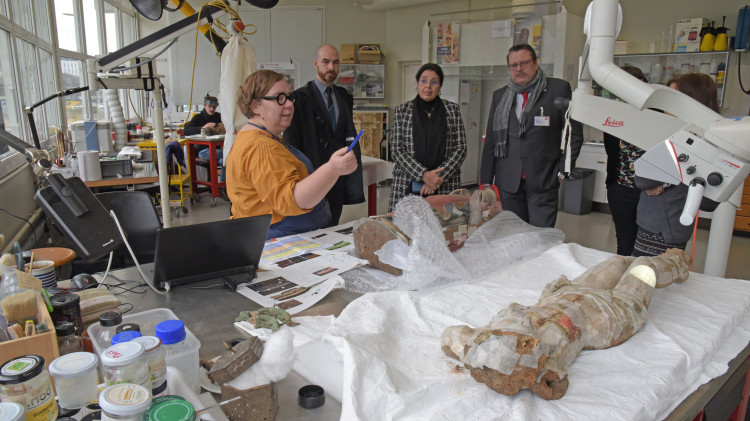Najat Mokhtar, IAEA Deputy Director General and Head of the Department of Nuclear Sciences and Applications, and Karine Froment, ARC-Nucléart Director, finalized a partnership by signing an agreement on Monday, February 27, 2023, at the French Atomic Energy Commission (CEA) Center in Grenoble. Representatives of France's Ministry of Culture, the city of Grenoble, the ProNucléart Association, and the CEA attended the ceremony.
The International Atomic Energy Agency (IAEA) as an autonomous international organization of the United Nations system, collaborates with designated institutions of its Member States to implement its programmatic activities. Focused on research, development and training, the IAEA Collaborating Centre scheme helps expand scientific and technical capabilities for the use of nuclear applications worldwide. Nuclear science and technology help reach important targets of the United Nations' Sustainable Development Goals, such as cultural heritage preservation.
The collaboration is focused on two major techniques in which ARC-Nucléart is specialized: insecticide and fungicide treatments by simple exposure to gamma radiation and consolidations by radiation-curable resins. ARC-Nucléart operates a unique irradiator in the world dedicated to heritage conservation and has built up a solid expertise in these fields since the 1970s.
"Thanks to the combination in a single multidisciplinary team of skills related to scientific and technical fields on the one hand, and cultural fields on the other, the IAEA's collaboration with ARC-Nucléart will generate direct benefits for cultural heritage preservation and will support international efforts," said Mokhtar.

After irradiation to preserve them from xylophagous insects, the wooden sculptures can go to the workshop where they are studied and restored. (Photo: ARC-Nucléart/ C. Terpent)
For more than 50 years, ARC-Nucléart's teams in Grenoble have been using gamma irradiation for cultural preservation. In addition to this specific activity, ARC-Nucléart has developed skills in the fields of conservation and restoration of archaeological objects made of organic materials and polychromed wood sculptures. Today, ARC-Nucléart is a key stakeholder in heritage conservation both nationally and internationally, thanks to its wide range of techniques and skills.
With this collaboration agreement, both organizations will join forces to promote the use of nuclear techniques for heritage preservation; optimize practices and disseminate knowledge following open science strategies; educate the public and future generations, and raise awareness on issues related to heritage conservation.
The support of the IAEA will facilitate knowledge sharing with scientists and conservators around the world. The diversity of technical and cultural approaches resulting from international exchanges will help advance and enrich the expertise of the parties involved. ARC-Nucléart's laboratories have already planned to host scientists from Asia for further training, thanks to the coordination with the IAEA. These are opportunities for ARC-Nucléart to establish and expand international collaborations.
The IAEA is the world's central intergovernmental forum for scientific and technical cooperation in the nuclear field. The Agency works for the safe, secure, and peaceful uses of nuclear science and technology, contributing to international peace and security and the United Nations' Sustainable Development Goals. These operational activities are grouped into five major programmes: nuclear energy, nuclear safety and security, nuclear science and applications, technical cooperation, and safeguards and non-proliferation verification.
The IAEA Department of Nuclear Sciences and Applications covers a broad range of socio-economic sectors, from health, food and agriculture, to the environment, water resources, and industry. It assists Member States to meet their development needs through nuclear science, technology, and innovation. It also works with laboratories, universities, and research facilities worldwide through the IAEA Collaborating Centre scheme.
About ARC-Nucléart
Located at the French Atomic Energy Commission (CEA) site in Grenoble, ARC-Nucléart is both a conservation-restoration workshop and a research laboratory. Thanks to its processes using gamma radiation and the size of its facilities, which enable it to treat large objects, it has a unique status in the field of heritage conservation both in France and internationally. ARC-Nucléart missions include the conservation and restoration of archaeological objects made of organic materials, such as wood, leather and basketry, which have been buried for one to several thousand years, as well as ethnographic or historical objects, for example polychromed wood sculptures.
Having recently celebrated its 50th anniversary, it became, in 1997, a Public Interest Group (GIP) initiated by several partners including the CEA, the French Ministry of Culture, the City of Grenoble, and the ProNucléart Association.






